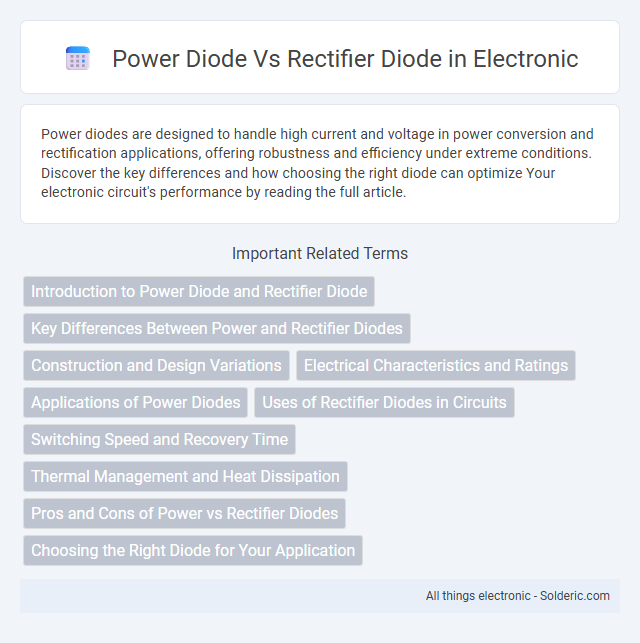Power diodes are designed to handle high current and voltage in power conversion and rectification applications, offering robustness and efficiency under extreme conditions. Discover the key differences and how choosing the right diode can optimize Your electronic circuit's performance by reading the full article.
Comparison Table
| Feature | Power Diode | Rectifier Diode |
|---|---|---|
| Purpose | Handles high voltage and current in power circuits | Converts AC to DC in low to medium power applications |
| Current Rating | High (typically >10A) | Low to medium (up to a few amps) |
| Voltage Rating | High (hundreds to thousands of volts) | Moderate (tens to hundreds of volts) |
| Recovery Time | Slow recovery, not suitable for high-frequency switching | Faster recovery, better for switching applications |
| Construction | Robust, designed for high thermal dissipation | Smaller, designed for general rectification |
| Applications | Power supplies, motor drives, inverters | Power adapters, signal demodulation, low-power rectification |
Introduction to Power Diode and Rectifier Diode
Power diodes and rectifier diodes are semiconductor devices designed to control and direct electrical current in high-voltage applications. Power diodes are optimized for handling large currents and high voltages with fast switching capabilities, making them suitable for power supply circuits and industrial equipment. Rectifier diodes primarily convert alternating current (AC) to direct current (DC) in power conversion systems, emphasizing efficient conductivity and low forward voltage drop.
Key Differences Between Power and Rectifier Diodes
Power diodes are designed to handle high voltage and current levels for power conversion and rectification in industrial applications, while rectifier diodes typically operate at lower currents and voltages in general-purpose electronic circuits. Power diodes feature larger junction areas and robust packaging to dissipate heat efficiently, supporting applications such as power supplies and motor drives. Rectifier diodes prioritize fast switching and low forward voltage drop for signal rectification in consumer electronics and smaller devices.
Construction and Design Variations
Power diodes feature robust construction with thick semiconductor layers and high current ratings to handle large voltage and current loads, while rectifier diodes typically have simpler designs optimized for converting AC to DC in low to medium power applications. The design variations include the use of different semiconductor materials and packaging techniques in power diodes to enhance thermal performance and durability. Your choice depends on the specific electrical demands, where power diodes ensure reliable operation under heavy electrical stress compared to standard rectifier diodes.
Electrical Characteristics and Ratings
Power diodes and rectifier diodes differ primarily in electrical characteristics and ratings, where power diodes are designed to handle higher voltage and current levels, often exceeding hundreds of amperes and kilovolts, suitable for high-power applications. Rectifier diodes typically operate at lower voltages and currents, focusing on efficient AC to DC conversion in moderate power circuits. Your application requirements determine the choice, with power diodes excelling in robustness and thermal performance, while rectifier diodes prioritize faster switching and lower forward voltage drop.
Applications of Power Diodes
Power diodes are primarily used in high-voltage and high-current applications such as power supplies, motor drives, and industrial rectification processes where efficient and reliable conversion of AC to DC is required. These diodes handle substantial electrical stress, making them ideal for use in inverter circuits, voltage regulation, and freewheeling diodes in power electronic systems. Unlike general rectifier diodes, power diodes are specifically designed to manage higher power levels, ensuring robust performance in demanding environments like renewable energy systems and automotive electronics.
Uses of Rectifier Diodes in Circuits
Rectifier diodes are primarily used in power supply circuits to convert alternating current (AC) to direct current (DC), enabling devices to operate on stable voltage. They serve crucial roles in bridge rectifiers, half-wave and full-wave rectification processes, ensuring efficient voltage regulation and reduction of ripple. Their ability to handle high current and voltage levels makes them indispensable in power conversion, battery charging, and voltage multiplier circuits.
Switching Speed and Recovery Time
Power diodes typically exhibit slower switching speeds and longer recovery times compared to rectifier diodes, which are designed for faster switching applications. Rectifier diodes feature low reverse recovery time, making them suitable for high-frequency circuits and efficient energy conversion. The enhanced switching characteristics of rectifier diodes reduce power loss and improve overall circuit performance in power electronic devices.
Thermal Management and Heat Dissipation
Power diodes and rectifier diodes differ significantly in thermal management and heat dissipation, with power diodes typically designed to handle higher currents and voltages, necessitating robust heat sinks and advanced cooling mechanisms. Their larger die sizes and superior junction temperature ratings allow efficient conduction and quicker heat dispersion, whereas rectifier diodes often manage lower power levels, requiring less intensive thermal solutions. Optimizing your circuit's thermal management involves selecting the appropriate diode type based on heat dissipation requirements to ensure reliability and prevent thermal runaway.
Pros and Cons of Power vs Rectifier Diodes
Power diodes handle higher current and voltage levels, making them ideal for industrial and high-power applications, but they tend to have slower switching speeds and larger sizes compared to rectifier diodes. Rectifier diodes offer faster switching and smaller form factors, suitable for low to medium power circuits, yet they may suffer from lower current ratings and less ruggedness under heavy load conditions. Your choice depends on balancing efficiency, switching speed, and power handling requirements for the specific application.
Choosing the Right Diode for Your Application
Power diodes and rectifier diodes serve distinct roles in electronic circuits, making the right choice critical for optimal performance. Power diodes, designed to handle high current and voltage, are ideal for industrial applications such as power supplies and motor drives, while rectifier diodes excel in low to medium power AC to DC conversion tasks. Selecting the appropriate diode depends on parameters like peak inverse voltage, forward current rating, switching speed, and thermal management requirements specific to the application.
Power diode vs Rectifier diode Infographic

 solderic.com
solderic.com